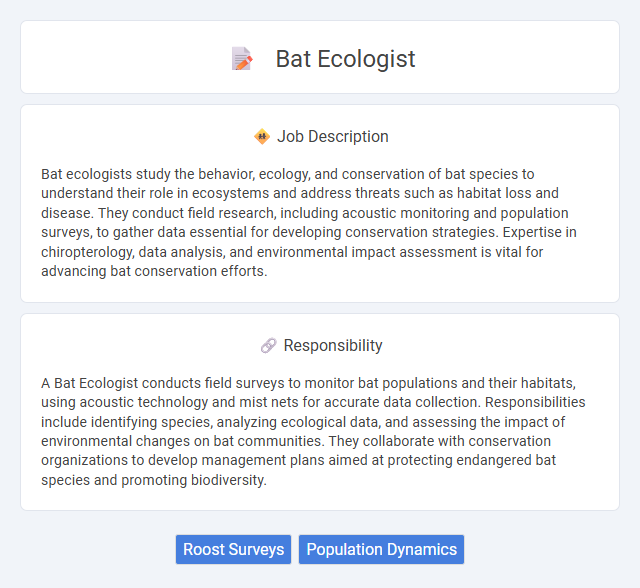
Bat ecologists study the behavior, ecology, and conservation of bat species to understand their role in ecosystems and address threats such as habitat loss and disease. They conduct field research, including acoustic monitoring and population surveys, to gather data essential for developing conservation strategies. Expertise in chiropterology, data analysis, and environmental impact assessment is vital for advancing bat conservation efforts.
Individuals with a strong interest in wildlife and environmental conservation may be well-suited for a Bat Ecologist role, as it involves extensive fieldwork, data analysis, and habitat assessment. People who are comfortable working outdoors in varying weather conditions and can tolerate irregular hours, including nighttime surveys, might find this job compatible with their lifestyle. Those with a cautious or fearful attitude towards bats or confined spaces may find the position less suitable due to the nature of close encounters and cave exploration.
Qualification
A Bat Ecologist typically requires a bachelor's or master's degree in wildlife biology, ecology, or a related environmental science field, with specialized training in chiropterology. Expertise in species identification, acoustic monitoring techniques, and habitat assessment is essential for conducting effective bat population studies and conservation efforts. Proficiency in data analysis software and strong fieldwork skills are crucial for accurate ecological research and reporting.
Responsibility
A Bat Ecologist conducts field surveys to monitor bat populations and their habitats, using acoustic technology and mist nets for accurate data collection. Responsibilities include identifying species, analyzing ecological data, and assessing the impact of environmental changes on bat communities. They collaborate with conservation organizations to develop management plans aimed at protecting endangered bat species and promoting biodiversity.
Benefit
Working as a bat ecologist likely offers the benefit of contributing to wildlife conservation and ecosystem health by studying bat populations and habitats. This role probably provides opportunities for field research, data analysis, and collaboration with environmental organizations. There is a chance to influence policy and public awareness on the importance of bat species and their protection.
Challenge
Working as a bat ecologist likely involves complex challenges in studying elusive nocturnal species with limited data availability. Fieldwork may require navigating difficult terrains and unpredictable weather to monitor bat populations effectively. Researchers probably face the ongoing challenge of balancing conservation efforts with human development pressures impacting bat habitats.
Career Advancement
Bat ecologists advance their careers by gaining expertise in chiropterology, wildlife conservation, and ecological research methods. Opportunities for growth include leading field studies, publishing peer-reviewed research on bat behavior and habitat, and collaborating with environmental agencies on conservation policies. Senior roles often involve managing research teams, securing grant funding, and advising on biodiversity management programs.
Key Terms
Roost Surveys
Bat ecologists specializing in roost surveys conduct detailed assessments to identify and monitor bat roosting sites, crucial for species conservation and habitat management. They utilize acoustic monitoring, visual inspections, and environmental DNA sampling to gather precise data on bat occupancy, behavior, and population health. Expertise in bat species identification and habitat requirements enables ecologists to provide vital recommendations for mitigating human-wildlife conflicts and supporting biodiversity preservation.
Population Dynamics
Bat ecologists specializing in population dynamics study the factors influencing bat population sizes, distribution, and growth rates to understand their ecological roles and conservation needs. They employ advanced statistical models and field data, including roost monitoring and acoustic surveys, to assess survival rates, reproductive success, and migration patterns. Insights gained from population dynamics inform strategies to mitigate threats such as habitat loss, disease, and climate change, ensuring sustainable bat populations and ecosystem balance.
 kuljobs.com
kuljobs.com